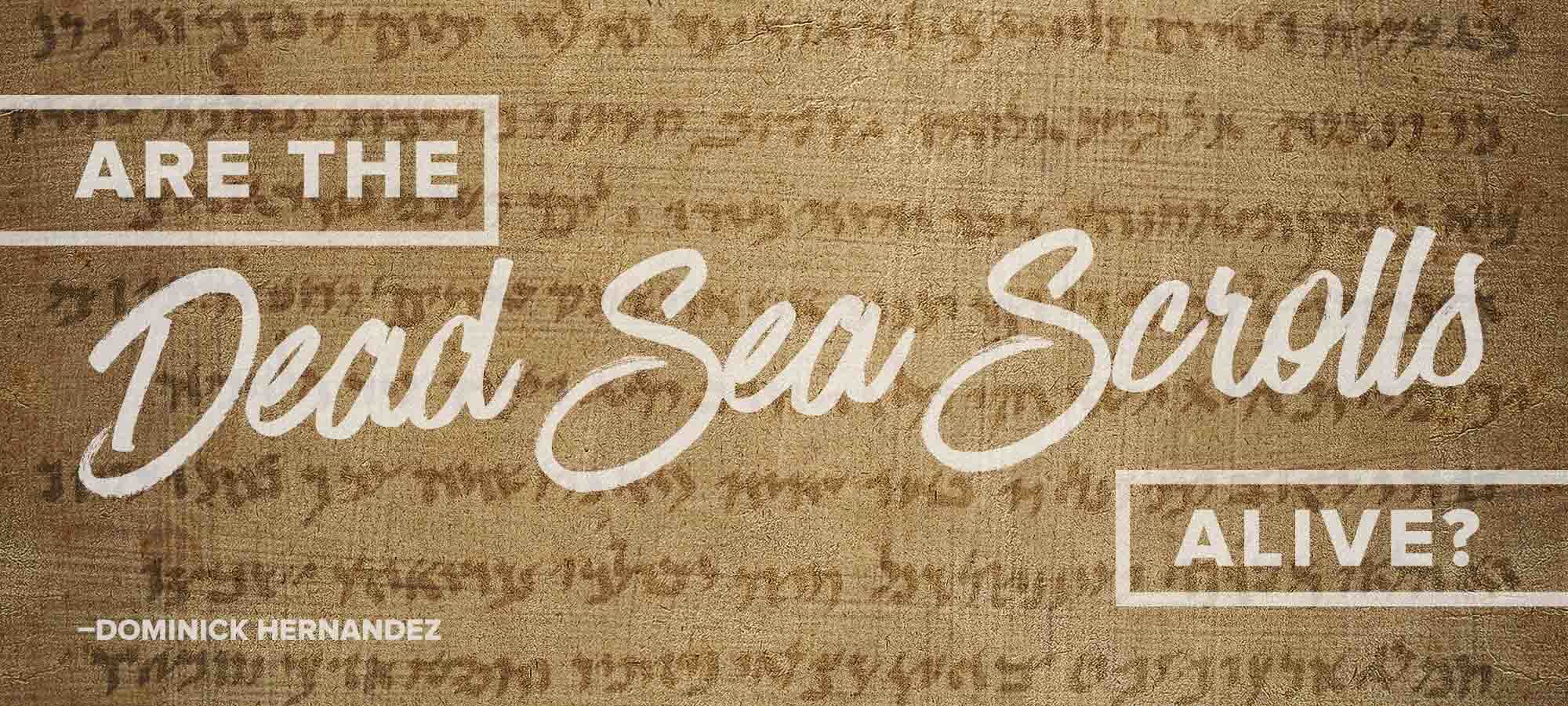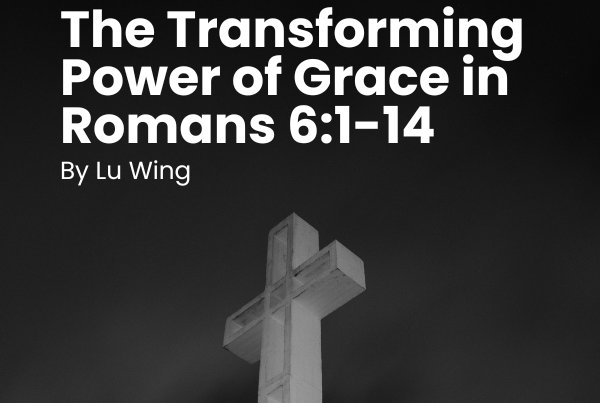
Dominick Hernández will be a workshop speaker at the 2017 CCCM Pastors & Leaders Conference on June 26-29. For more information, please visit the website.
Introduction
Have you ever heard the story of the Bedouin lad who threw a stone into a cave on the western shore of the Dead Sea, unwittingly making the greatest find in recent centuries related to biblical studies?
This is the story behind the discovery of what are now called the Dead Sea Scrolls—conveniently named for the location in which they were unearthed. In late 1946 or early 1947, three Bedouin shepherds (Khalil Musa, Jum`a Muhammed Khalil, and Muhammed edh-Dhib [aka “the Wolf”]) tended their herds in the area of Khirbet Qumran. Jum`a—perhaps looking for an animal—threw a rock into a cave and heard pottery break. The story has it that they decided to return to the cave later, but the Wolf (Edh-Dhib) came back first without the other two. He found three scrolls in a clay jar and brought them back to his companions. Later, they returned to the cave again with another interested person, George Isha`ya Shamoun, and found several more sizeable scrolls, totaling seven.
Once scholars and seasoned archaeologists learned of the vicinity of the findings, they were able to conduct professional excavations. When all was said and done, there were ten more caves found in the proximity of the first between 1947 and 1956. These eleven caves contained fragments numbering in the tens of thousands, constituting between 900-1000 assorted manuscripts (depending, of course, upon which scholar you ask, and how the fragments are compiled and counted). These fragments are dated back to the third century BC through the first century AD, and were written in Hebrew, Greek and Aramaic.
Scholars also discovered the archeological remains of a nearby settlement and were able to make some deductions based upon the contents of the scrolls and the distinct structural features of the encampment. It was determined that these scrolls were likely conserved, preserved, and eventually, left behind by a radically ascetic Jewish group during the time of the first major Jewish rebellion against Rome (66-74 AD). Most scholars believe that the Qumran settlement was inhabited by the historically-documented (mostly by Josephus, Philo, and Pliny the Elder) Jewish group known as the Essenes.
Maybe you have heard this story, or perhaps have read something like this in your study Bible. Maybe you have even taken a trip to Israel, stood on the platform adjacent to the ruins of Qumran overlooking cave four and wondered if your tour guide would ever stop talking—after all, it is quite hot in the Judean hills almost year-round.
When it comes to the relevance of the Dead Sea Scrolls, even the serious Bible student who is interested in extra-biblical information might ponder, “Neat story—but what in the world do Qumran, the Essenes, and the Dead Sea Scrolls have to do with me now? How are the Dead Sea Scrolls important for the church today?”
These are perfectly fair questions, especially in light of the timeless scholarly tendencies to major in the minors. Bible students can sometimes become engrossed in peripheral minutia relating to the Bible, not giving priority to the important task of sound theological interpretation. Nevertheless, there are indeed numerous ways in which the Dead Sea Scrolls are immediately, pragmatically useful for students of the Bible. This brief article will outline three reasons as to why the Dead Sea Scrolls are important for Christians today.
The Oldest Manuscripts—by Far
Of the 900-1000 manuscripts, about 250-300 of the Dead Sea Scrolls are biblical, with the books of Deuteronomy and Psalms represented the most. In fact, manuscript fragments of all of the books that constitute the Hebrew Bible/Old Testament are found among the Dead Sea Scrolls, except for the book of Esther. The inhabitants of Qumran studied, for the most part, the same scriptures that you and I have in the Old Testament of our Bibles today.
What is particularly noteworthy with regard to the Dead Sea Scrolls is the dating of these manuscript fragments. Through paleography (i.e. the analysis of handwriting) and radiocarbon testing, most of the fragments have been dated to the third century before Christ. That might not sound like such a big deal, but let’s look at what this means as far as Old Testament manuscript evidence is concerned.
There are currently no extant original manuscripts (autographs) of any section of the Bible. Despite there being a number of witnesses throughout antiquity—predominantly by way of translation—the earliest complete Hebrew edition of the Old Testament is the Leningrad Codex (aka, in published form, the Biblia Hebraica Stuttgartensia [BHS]), which dates to the early eleventh century AD. This is still the main manuscript that translators utilize to render Old Testament versions in every major Bible translation, both traditional and modern (e.g. KJV, ESV, NIV, NASB etc.). In order to fully grasp the implications of this, it is important to understand a bit more of the history of the Qumran settlement. Why did the Qumran settlers apparently leave these scrolls in the caves?
The predominant theory concerning how and why the scrolls ended up in the caves proposes that the settlement at Qumran was destroyed during the First Jewish Revolt. This would have likely occurred either in 68 AD by Roman general Vespasian or in 73 AD by General Silva as he marched southward toward Masada, intending to subdue the last Jewish stronghold. In either of these proposed times, prior to the Romans arriving at Qumran, the settlers—and perhaps, other members of the sect from outside of Qumran—hid their scrolls in the caves surrounding the encampment with the intent of returning to them after the conflict with the Romans subsided. Qumran was destroyed and the scrolls were left relatively untouched until the Bedouin boy’s animal went astray, centuries later.
Granting that one of the aforementioned dates for the destruction of the Qumran site is legitimate, the latest possible date for the production of any of the Dead Sea Scrolls found in the caves was around 70 AD (the year of the destruction of the Temple in Jerusalem). This means that the youngest Dead Sea Scrolls predate the completed manuscript of the Old Testament by at least 900 years, while some fragments are over 1,200 years older than their BHS counterparts. Prior to the publications of the major Dead Sea Scrolls materials in the years after which they were discovered, scholars did not have nearly the quantity of Hebrew and Aramaic manuscripts they could compare to the Leningrad Codex. The original language of Old Testament text that we read today can now be looked at alongside these texts from antiquity, and much of it is corroborated by a significant portion of the Dead Sea Scrolls. While there is no guarantee that older manuscripts always have the most original wording, the ability to compare the Bible with so many ancient copies is nevertheless a privilege no other generation of Christians since antiquity has been able to claim.
Textual Criticism
As scholars analyzed the biblical documents of the Dead Sea Scrolls, it quickly became evident that there existed various textual traditions in the Qumran library. For example, some of the biblical fragments that were found very closely represent the Leningrad Codex, yet other manuscripts closely resemble the Greek translation of the Hebrew text, commonly referred to as the Septuagint (LXX). There are additional texts that look very much like the Samaritan version of the Pentateuch and others remain unidentified. This diversity in manuscript traditions helps those interested in biblical studies engage in textual criticism (aka “lower criticism”)—a goal of which is to establish the most original form of any given text.
One example of how the Dead Sea Scrolls provide useful information for textual criticism is seen in the difficult Hebrew wording in the first half of Isaiah 53:11. A literal translation of the Hebrew can be awkwardly rendered, “From the suffering of his soul, he will see, he will satisfy…” (my translation).
It is certainly possible to understand the words, and even several distinct phrases in this passage, but the overall meaning is unclear. What exactly is the prophet trying to communicate? The difficult Hebrew is smoothed out in the NKJV of Isaiah 53:11a. We read, “He shall see the labor of His soul, and be satisfied.”
Notice at least two interpretive moves by the translators of the NKJV in order to provide this difficult verse with a logical meaning. 1) The word “and” is inserted into the text. 2) The word “satisfy” is rendered in the passive, not conforming to the active form of the verb as it is written in the Leningrad Codex. Other Bible translations render similar versions of this verse, “Out of the anguish of his soul he shall see and be satisfied…” (ESV) “As a result of the anguish of His soul, He will see it and be satisfied…” (NASB)
Despite these interpretive translations, it still takes a little bit of imagination to grasp what the author is striving to communicate. After all, whom is Isaiah talking about? What is that person seeing? Why is this person satisfied?
Some of these questions are clarified a bit when considering the NIV translation of this particular verse, “After he has suffered, he will see the light of life and be satisfied…” (Isaiah 53:11 NIV). The NIV explicitly states that the subject of the sentence sees “the light of life” and implies that upon seeing that light, he will be satisfied. Where do these translators get the liberty to insert the phrase “light of life”? That is a question that is answered by a quick glance at this same verse in a Dead Sea Scroll called The Great Isaiah Scroll (aka 1QIsaa). This scroll is the largest Dead Sea Scroll and contains the entire book of Isaiah in a very well preserved condition. This document rendered Isaiah 53:11 in the following manner, “From the suffering of his soul he will see light and satisfy (or: be satisfied).” (Translation mine).
The words “light” and “and” appear in the Great Isaiah Scroll. This reading also aligns with the Septuagint in that the Greek words for “light” and “and” appear in the same positions in the sentence. Now this is all starting to make sense.
Traditional Christian understanding of Isaiah 53 considers it to be prophecy of the passion of Jesus. Ultimately, Jesus would go to the cross as a sin offering, effectuating the words foretold by Isaiah hundreds of years before Jesus’ birth, “Yet it was the will of the LORD to crush him; he has put him to grief…his soul makes an offering for guilt…the will of the LORD shall prosper in his hand.” (Isaiah 53:10 ESV)
According to the reading of the Great Isaiah Scroll, just after the Suffering Servant makes a sin offering through His death, He sees “light and satisfies (or: is satisfied).” Could it be that “light” in this context refers to Jesus’ resurrection? Is it through Jesus’ resurrection that He “satisfies” the will of the Father (or: He “is satisfied”)? Does the textual evidence in 1QIsaa and the Septuagint in favor of reading “light” finally provide the information needed to understand this difficult text? Whether one adopts the reading by the NIV as is supported by 1QIsaa or not, the Dead Sea Scrolls clearly enable us to have conversations about the biblical texts’ original forms that were impossible prior to their discovery.
Insight into the World of Jesus: Jewish Sects and Second Temple Judaism
Toward the end of the period in which the Qumran settlement was inhabited, a revolutionary Jewish teacher from the Galilee rose to prominence whose mission was carried out through performing miracles, challenging misguided interpretations of the Tanach (the Christian Old Testament), and boldly calling all people—regardless of gender, socio-economic class, or ethnicity, to believe in Him as the way to God the Father. While Jesus of Nazareth lived a much different kind of life than those of the Essenes of Qumran, He was born, conducted His ministry, died, and resurrected during their active years. Therefore, we look to the Dead Sea Scrolls—the main way in which we are able to access information about the religious Jews who inhabited Qumran—for insight into the world of Jesus.
As Christians, we are so used to turning the last page of Malachi, seeing a blank page bearing the almost arbitrary words “The New Testament” and moving on to Gospel of Matthew. Nevertheless, during that two-page flip of the index finger, several hundred years of history transpired. These years included the rise and fall of the Persian and Greek Empires, as well as the ousting of the Hasmonean dynasty by the Romans. Curiously, during this same time period, at least two distinct Jewish religious sects emerge, debuting on the pages of the Gospels—the Pharisees and the Sadducees.
Prior to the discovery of the Dead Sea Scrolls, the New Testament was the primary, though not exclusive, resource for Christian understanding of Jewish sectarianism during the Second Temple Period. The New Testament remains the fundamental means of knowledge concerning the Pharisees and Sadducees, but the discovery of the Dead Sea Scrolls has shed light upon the Gospels’ depictions of these groups as well as provided a more comprehensive picture of Judaism during this time period.
It is particularly evident through the sectarian writings of the Dead Sea Scrolls that the group that inhabited Qumran saw themselves as the real doers of the Law. That is, their strict interpretation of how to practically carry out the commands of the Old Testament were exclusively legitimate. In their writings, the Pharisees were pejoratively nicknamed the “Seekers after Smooth Things,” suggesting that their interpretation and application of the Law was exceedingly lenient. This is an accusation that apparently dissents from the New Testament assessment of the Pharisees. However, this does not imply that the Dead Sea Scrolls contradict the New Testament portrayal of the Pharisees. On the contrary, through the Essene community’s portrayal of the Pharisees and self-representation in their writings, we are able to observe that there was a group that was even more exacting in their understanding of the Torah.
Considering the devout religious nature of the Jews at Qumran, one would think that Jerusalem would be a more ideal location for such a sect. After all, Jerusalem is where the Temple was located. The Essene community was certainly concerned with the study of the Torah, worship, and purity—a fact evident by the large number of ritual cleansing baths (mikva’ot) found in the ruins at Qumran. However, the sectarian documents of the Dead Sea Scrolls indicate that the Essene community was not only dissatisfied with the leadership in the Jerusalem Temple, but they openly repudiated the establishment. This disavowal of the Jerusalem Temple implicitly assails two other Jewish groups from antiquity: The Hasmoneans, who—after liberating the Jewish people from Greek oppression—subjugated their own people, reigning as kings and High Priest; and the Sadducees, who the New Testament attests to as the autocratic rulers of the Temple. Hence, the Essene sectarians—believing themselves to be the righteous remnant and the voice crying in the wilderness (Isaiah 40:3)—retreated to the Judean hills to await their Anointed One.
The longing for the ultimate redemption of their people by an Anointed One is seemingly a shared characteristic by the Jewish sects of the Second Temple Period. Despite the limited literature from this era directly addressing the messianic hope of the Jewish sects, the available sources suggest that the Jewish people expected an anointed figure to fulfill prophecies of the Old Testament and liberate the people of Israel. This messianic hope is shared by the Qumran sectarians who, along with the biblical writers, understood Genesis 49:8-12, Isaiah 11:1-5, and Numbers 24:17 to be messianic.
More specifically, there are several Dead Sea Scrolls that demonstrate the messianic hope using similar rhetoric to the writers of the New Testament and, perhaps, even shared theology concerning the messianic figure. For example, a scroll fragment entitled The War of the Messiah (4Q285) anticipates the Branch of David defeating the Roman army (the Kittim). The Melchizedek text from cave 11 (11QMelchizedek) suggests that Qumran sectarians may have understood this messianic figure to be divine, indicating that Melchizedek atones for his people.
Conclusion
We have barely scratched the surface of how the Dead Sea Scrolls and the Qumran community inform the studies of biblical language, textual criticism, and Jewish sectarianism during Jesus’ life. The significance of the Dead Sea Scrolls extends into many more arenas: eschatology, early Jewish interpretation of the Law, overlapping genres (e.g. apocalyptic, wisdom), and biblical metaphors and imagery (e.g. the dichotomy between light and darkness). These writings help to contextualize the scriptures and in turn give us a better grasp on the thought world of the New Testament.
A generation after the discovery of the Dead Sea Scrolls, scholars and laypeople alike are still immersed in studying their content and implications. The benefits of these documents are not just for the academic world. The Dead Sea Scrolls have proven themselves to be very much alive, overflowing with helpful information for Christians who love to study their Bibles.
For further reading:
John J. Collins, The Dead Sea Scrolls: A Biography. Princeton: Princeton University Press, 2013.
Craig Evans, Holman QuickSource Guide to Dead Sea Scrolls. Nashville: B&H Publishing Group, 2010.
Lawrence Schiffman, Reclaiming the Dead Sea Scrolls. New York: Doubleday, 1995.
James VanderKam, The Dead Sea Scrolls Today. 2d ed. Grand Rapids, MI: Eerdmans, 2010.
Peter W. Flint, The Dead Sea Scrolls. Core Biblical Studies. Nashville: Abingdon, 2013.






